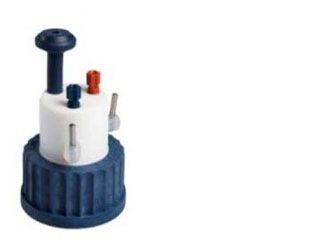Agilent Solvent Safety Caps
Confidence is knowing that you're covered. Open or partially covered solvent bottles can lead to the evaporation of solvents and harmful solvent vapors. Keep solvents where they belong with Agilent solvent safety caps.
Two great offers for Agilent Solvent Safety Caps!

For more information visit us at www.agilent.com/chem/solventsafety
Contact us at www.chromnews.com/contactus.html
Put a Cap on it – Agilent Solvent Safety Caps
Confidence is knowing that you’re covered. Open or partially covered solvent bottles can lead to the evaporation of solvents and harmful solvent vapors. Keep solvents where they belong with Agilent solvent safety caps.
Manufactured with special technology, solvent safety caps minimize solvent leakage into the air.
Request your FREE TRIAL safety cap at www.agilent.com/chem/solventsafety
How Solvent Safety Caps Work
When the HPLC pump is operating, the PTFE membrane in the valve opens and allows air to flow into the bottle. When the pump stops, the valve closes, keeping solvent vapors from escaping.
To purchase solvent safety caps for all your LC instruments and solvent waste containers, visit us at www.agilent.com/chem/safetycaps
The Complexity of Oligonucleotide Separations
January 9th 2025Peter Pellegrinelli, Applications Specialist at Advanced Materials Technology (AMT) explains the complexity of oligonucleotide separations due to the unique chemical properties of these molecules. Issues such as varying length, sequence complexity, and hydrophilic-hydrophobic characteristics make efficient separations difficult. Separation scientists are addressing these challenges by modifying mobile phase compositions, using varying ion-pairing reagents, and exploring alternative separation modes like HILIC and ion-exchange chromatography. Due to these complexities, AMT has introduced the HALO® OLIGO column, which offers high-resolution, fast separations through its innovative Fused-Core® technology and high pH stability. Alongside explaining the new column, Peter looks to the future of these separations and what is next to come.
Metabolomics Analysis of Low Birth-Weight Infants Using UHPLC-MS/MS Following Lipid Emulsion
January 10th 2025A recent study aimed to directly compare the changes in serum metabolites among very low birth-rate (VLBW) infants following the administration of the soybean oil-based lipid emulsion and soybean oil, medium-chain triglycerides, olive oil, and fish oil (SMOF) lipid emulsion using untargeted metabolomics techniques.
Analyzing New Drug Modalities: An ISC 2024 Interview with Kelly Zhang
January 10th 2025At ISC 2024 in Liverpool, United Kingdom, LCGC International interviewed Kelly Zhang of Genentech about her work analyzing new drug modalities, such as mRNA, oligonucleotides, peptides, and cell and gene therapies.